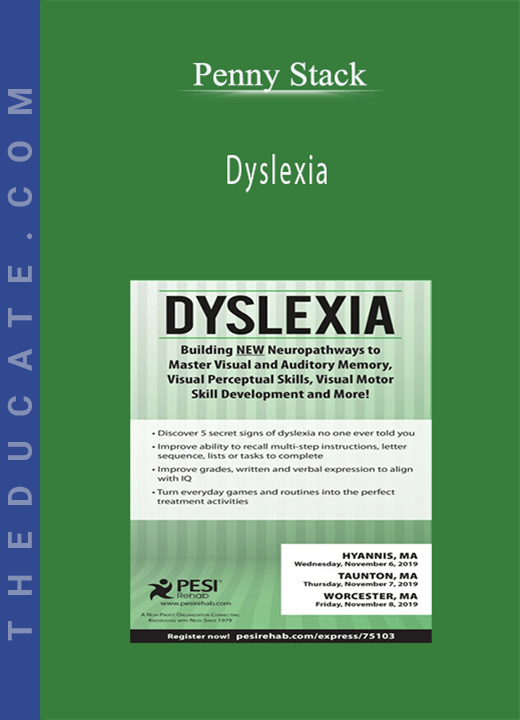Description
Dyslexia: Building NEW Neuropathways to Master Visual and Auditory Memory, Visual Perceptual Skills, Visual Motor Skill Development and More! – Penny Stack
Dyslexia – the invisible disability that impacts 1:5 individuals!
It’s not just an issue of trying harder or paying attention.
You know the stories you hear from your clients – hours of studying just to forget it all on a test the following day, constant lack of ability to understand what they read, difficulty remembering lists or instructions beyond three, the overwhelming frustration of knowing what they want to say or do, but not being able to express it on paper or get the words out, socially withdrawn in attempt to hide their struggles.
In this recording, you will have the opportunity to practice treatment ideas that will incorporate the use of client-centered everyday routines, games, technology, sensory and hands-on approaches to help your client overcome the challenges of life with dyslexia.
Upon completion of this program, you will be able to immediately provide treatment to address your client’s:
- Visual perceptual skills
- Visual motor integration
- Auditory and visual memory
- Reading rate, accuracy, fluency, comprehension
- Phonetic awareness and memory
- Spelling and handwriting struggles
Turn everyday activities into successful treatment!
- Analyze the 3 types of dyslexia and their characteristics to establish a treatment plan.
- Determine the executive cognitive functions and treatment methodologies that impact processing speed and reading comprehension.
- Choose treatment strategies to address visual perceptual, visual motor integration, auditory and visual memory deficits to increase handwriting legibility, reading comprehension, and ability to follow multi-step directions.
- Communicate how to integrate electronic and low tech games into treatment activities to increase reading comprehension, ability to follow multi-step directions for increased academic success.
- Apply compensatory strategies to each specific type, such as recital, chunking, and mnemonics as they apply to visual and auditory memory.
- Establish 3 strategies to improve client’s ability to recall multi-step instructions and letter sequence for spelling.
Dyslexia
- Where it originated
- Facts verses myths
- The public health impact
Assessment for Cognitive Function
- Visual and auditory memory
- Phonological awareness and memory
- Visual perceptual skills
- Visual motor skills
- Handwriting skills
- Reading rate, accuracy, fluency and comprehension
Treatment Strategies for Redeveloping Neuropathways
- Visual perception skills to:
- Keep up with note taking in class
- Remember multi-step instructions
- Remember the order of letters when spelling a word
- Remember how to do homework once at home
- Memory skills/phonological awareness to:
- Remember more than 1 or 2 instructions at a time
- Interpret words as they were intended: cat verses hat
- Spell aloud
- Visual skills to:
- Discriminate different fonts
- Form letters or numbers
- Not write letters or numbers backwards
- Help with mixing up letters/numbers – /d/ from /b/ or /E/ from /3/
- Find their pencil in their desk
- Find matching socks when dressing
- Visual motor skills to:
- Copy notes in time to keep up with the class
- Tie shoes
- Ride a bike
- Become more coordinated
- Handwriting skills to:
- Help with slow, messing writing or letter formation or letter spacing
- Printing
- Write in cursive
- Reading/comprehension skills to:
- Read at age or grade level
- Pseudoword reading to match word reading level
Practice Treatment Interventions and Case Studies Throughout the Day
Documentation and Billing
- ICD-10 treatment diagnostic codes and CPT billing codes for reimbursement of provided services







4 reviews for Dyslexia: Building NEW Neuropathways to Master Visual and Auditory Memory, Visual Perceptual Skills, Visual Motor Skill Development and More! – Penny Stack
There are no reviews yet.